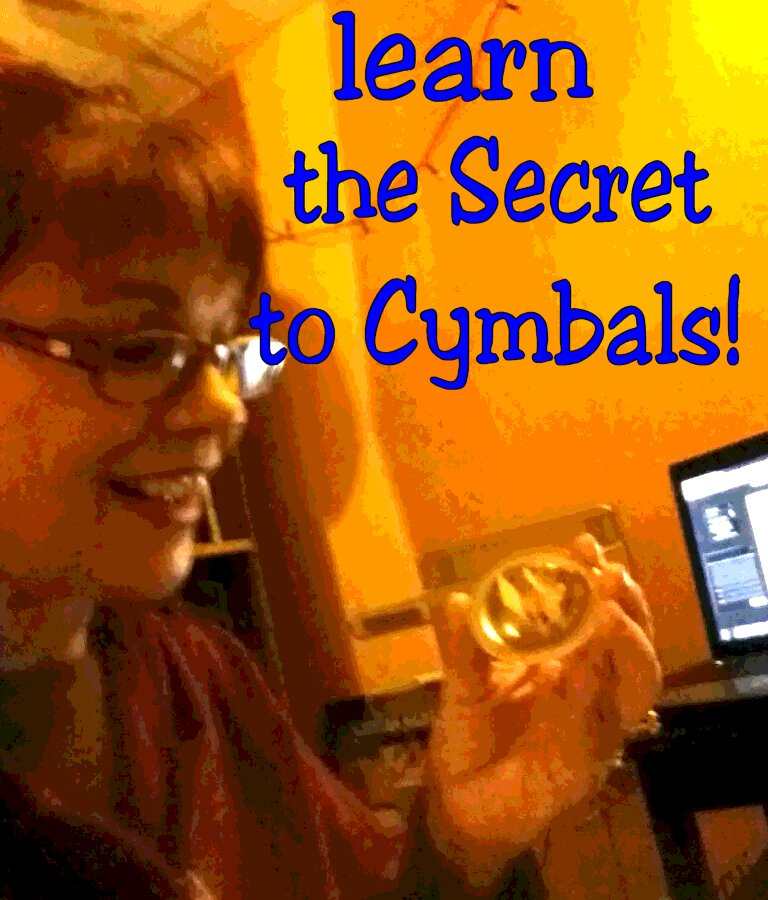Seven Tips for Playing Finger Cymbals, or Zills
|
Zaghareet! Magazine (Nov/Dec 2010)
FOR BEGINNERS column
by Anthea Kawakib Poole
My Best Advice For You About Cymbals
Let’s close this series of
articles on playing finger cymbals with some last words of advice.

Be Real
Finger cymbals are the icing on
the cake, the “extra something” added to your dance. Your
dance comes first, then the cymbals. Don’t use them to
distract the audience from your dancing or pretend that you’re
more capable than you are. The only person you’re fooling is you!
Always represent yourself and your dancing at the level it really
is, because when you actually dance, it will speak for itself.
That’s why I recommend matching the performance to the venue, and
vice versa. You can also make sure your “bio” or “introduction”
includes the fact that you’re a student, or are new to performing,
or new to playing cymbals, whatever the reality is - then the
audience won’t feel like you’ve tried to trick them and failed.
There’s no shame in being a beginner but there IS (or
should be) shame in fraud. If that sounds harsh, think back to
when you’ve attended a show and suffered through a performance by
a dancer who just shouldn’t have been wearing finger cymbals...
Be Considerate
Do not bring your cymbals to a
belly dance show unless YOU are performing! No one else wants to
hear you play from your seat, or during open dancing. It’s like
bringing your own guitar to a concert and strumming in the
audience - it’s rude and inappropriate. Challenge yourself
to learn a dance with finger cymbals that you can share with
others as a real performer onstage, not an audience member begging
for attention.
Be Diverse
Want to drive yourself and the
audience nuts? Then play only one or two patterns over and over
throughout your entire dance. Yes, I’ve seen that done, and unless
you’re one of the Egyptian Ghawazee - or portraying one onstage -
learn a few different patterns and incorporate them in your
dance where they make sense. After all that’s why I’ve been
writing these articles for the past couple of years!
Be Serious
Don’t bother with cheap
cymbals, even to practice with - they sound terrible. A
good, brand-new starter set can be found for around $20. Don’t
skimp on the price, because cymbals last for years and years, and
certainly no one wants to hear thin, clanking, un-tuned cymbals
for even a few minutes!
Be Quick
For heaven’s sake, this is one
of my pet peeves! When it’s time for cymbals in class,
sometimes I just sit down and take a break while I wait for
everyone to get them on. Frequently I’ll give my students a
30-second time limit to put them on, but honestly that’s still
too long. After a few months of playing cymbals it shouldn’t
take longer than 10 - TEN - seconds! I’m klutzy with my
fingers, but even I can get cymbals on this quickly. Also,
“quickness” is the reason we decorate cymbals with paint, nail
polish, beads on the elastic, etc. – so that we can pick them up
and quickly - I repeat, quickly
- know which digit they go on. Don’t bother with different color
thread on the elastic, that may not show up in the backstage
darkness.
Be Precise
Have you noticed I call these
little pieces of metal “Finger Cymbals”? That’s English for
sagat (Arabic) or zills (Turkish). If you dance in the Turkish
style then of course call them zils, but if you dance Arabic
style, why would you? Use the correct term sagat or, if you
speak English, finger cymbals. This is especially important when
you’re dealing with Middle Eastern people (club managers,
clients, etc.), get the picture? You want to impress them, but
with your expertise, not ignorance. Using the wrong term is
just kind of sloppy.
Be Brave
Yes, playing finger cymbals
can be difficult. But almost everyone can learn to play them.
Take the challenge of learning this amazing skill, it’s so worth
the effort. Learning to play them helps you become aware of
tempo, timing, rhythms, not to mention arm positions! Your
dancing will improve because of them, just a few minutes a
couple of times a week. You have my step-by-step videos to
learn with so there’s no excuse!
As always, I welcome your
comments and questions on these articles or the videos on my
YouTube channel. Good luck!
